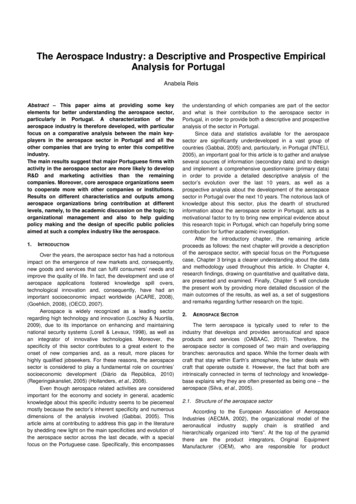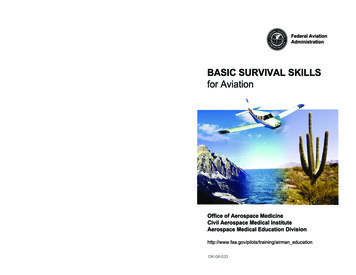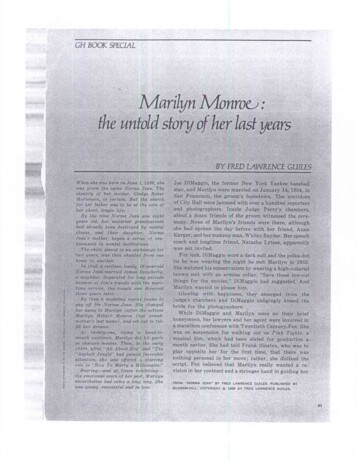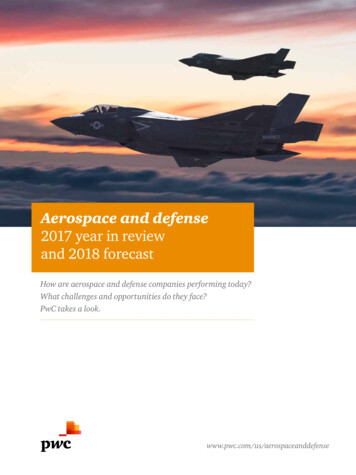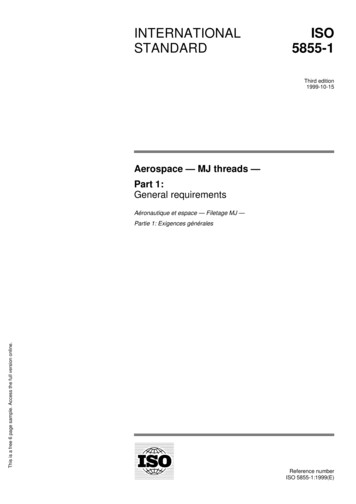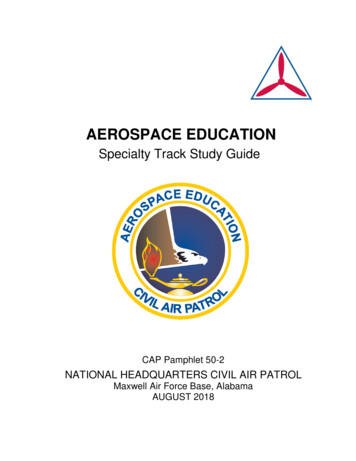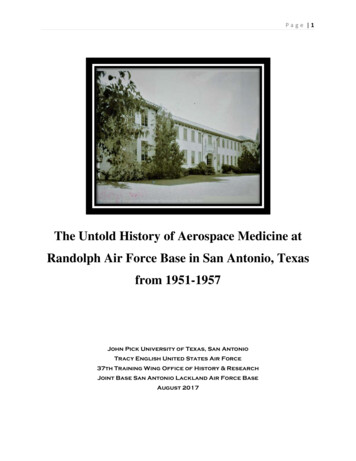
Transcription
Page 1The Untold History of Aerospace Medicine atRandolph Air Force Base in San Antonio, Texasfrom 1951-1957John Pick University of Texas, San AntonioTracy English United States Air Force37th Training Wing Office of History & ResearchJoint Base San Antonio Lackland Air Force BaseAugust 2017
Page 2Preface11, August 1951 the time is 5:00 am at Randolph Air Force Base in San Antonio, Texas.Randolph’s Airmen from around the United States of America are sleeping in their barracks,dreaming of flying and exploring new lands for what awaits them. All seems peaceful in thesequiet little barracks, until the Drill Sergeant blows his powerful trumpet. All Airmenimmediately wake up from the Drill Sergeant’s tune and quickly follow the routine they beenlearning for the past few weeks. Once the Airmen lined up, they began their morning training.Some learned Flight training, Aeromechanics, Refueling Aircraft and other special training.There was one field that was becoming an important and professional field in the U.S. Air Force.This necessary field was Aviation Medicine.Lt Kathryn Mehalick and Grace Haynes of the Department of Ophthalmology from theSchool of Aviation Medicine on a float from “SAM” for the San Antonio San Jacinto FiestaParade 1952
Page 3The untold history of Aerospace Medicine at Randolph Air Force Base in San Antonio,Texas 1951-1957Aviation Medicine is the study of how air and space travel affects the human body andwhat ways can aviation doctors treat and overcome the obstacles that pilots face in aviation andspace travel. In the 1950’s, aviation medicine was not only being taught to officers in training,but to Airmen as well. To understand aviation medicine of the 1950’s, the readers will have tolook at the History of Aviation Medicine. To begin this journey, the readers must look backwhen and why aviation medicine started.The HistoryAviation Medicine began 100 years ago in 1917. The world was experiencing its firstWorld War. World War I, or The Great War as it was called by many, started in 1914 and endedin 1918 with the Allies (U.S., Britain, France, Japan, Russia, China etc.) going up against theCentral Powers (Austria-Hungary Empire, Germany, Bulgaria and the Ottoman Empire). Inmany ways, World War I was the first war to use aerial warfare and both sides were noticing thatpilots were experiencing medical problems that were unheard of. This caused the Allies,especially the U.S. Military, to create a medical branch within the military that dealt withAviation. Thus, Aviation Medicine was born and since then, has helped the U.S. Air Forceachieved air superiority. The big question now is what was the best location of doing AviationMedicine research that would shape the Aerospace community of the future? From documentsand accounts of personnel, it seems that Randolph Air Force Base at San Antonio from the 1950swas the leading expert in Aviation Medicine research/education.The School of Aviation Medicine (SAM) was created in 1931 at Randolph Air ForceBase in San Antonio, Texas. The school soon became known around the world for their work inresearch, experiments and education of students in Aviation Medicine. The school included
Page 4students from all military branches, including international military students. 1 Many medicallyrelated historical events occurred at the SAM during the 1950s, with a number of notable peoplespending time at Randolph to learn and research new discoveries. Faculty at both Harvard andJohn Hopkins Universities made alliances with their counterparts at SAM. This in itself provedthe norm rather than the exception as SAM personnel remained in contact with any number ofuniversities from around the world. To have a better understanding of what was happening at thetime, a chronological time line is best suited to show and explain the events that were transpiringat SAM during the 1950s.Figure 1The Logo of the School of Aviation Medicine 21The International military Students that came to SAM were from Britain, France, Italy, Greece, Pakistan, India,Pacific Islands, Columbia, Brazil, Peru, Puerto Rico, Norway, Yugoslavia, Belgium, Japan, South Korea, SaudiArabia, Iran, Egypt, Israel, Australia, Ecuador, Canada and other allies from around the world during the 1950s.2“SAM’s MOTTO/LOGO” Photograph from School of Aviation Medicine, USAF History Volume 15 1 July- 31December, 1952
Page 5Chronological time line of events that happened from 1951-1957In the Year 1951 Paper Clip Scientists were included in the assigned strength for studying AerospaceMedicine at Randolph Air Force Base. 3 These Paper Clip scientists were former GermanNazi technologists that came to the U.S. and assisted the military; in part, they also didthis to get away from the possibility of being kidnapped by the USSR who was engagedin abducting German scientists working in East Germany. These German ex-patriots didnot believe in the Nazi cause, and thought that by working with the Americans and theirallies, they could fix the mistakes they made during World War II. One of the mostfamous scientist in this group that was well known by both the scientific community andthe U.S. Military was Dr. Wernher Von Braun 4.Doctor Wernher Von Braun was a rocket engineer who created the German V-2rocket and later in his career, created the Saturn V rocket for the US. The Apollomissions used the Saturn rocket thattransported American astronauts to themoon in the mid and late 1960s. Thanksto these scientists, SAM personal had abetter understanding on aviationmedicine.Figure Dr. Wernher Von Braun 53Semiannual History S.A.M. Volume 13 1 July to 31 December, 1951 page 5.4Wernher Magnus Maximilian Frehiherr von Braun.5Edward Owen. “Wernher Von Braun would come to personify NASA's space exploration.” Smithsonian.com,NASA, Science Faction, Corbis. August 2011. -von-brauns-v2-rocket-12609128/
Page 6 Brigadier General Otis. Benson Jr. severed as Commander of the School of AviationMedicine from 1951-1953. He was a former graduate of the school in 1932. Also, he hadthe distinction of serving with General James H. Doolittle and General N. F. Twiningduring the 1940s and 1950s. 6Figure 3Brigadier General Otis Benson Jr. 76Semiannual History S.A.M. Volume 13 1 July to 31 December, 1951 page 77Photograph from Semiannual History S.A.M. Volume 13 1 July to 31 December, 1951.
Page 7 San Antonio Symposium for Aerospace Medicine began on 9 November, 1951. In thisSymposium, there were three notable guests. Of these three notable guests were MajorCharles E. Yeager, a United States Air Force Test Pilot that was the first person to brakethe Sound Barrier. Bill Bridgman, a former U.S. Navy Pilot and Douglas Aircraftcompany (now McDonnell Douglas Aerospace Company) Test Pilot who was the firstperson in the 1950s to break the world record of reaching the highest speed and altitude atthat time. Finally, Dr. Wernher Von Braun, an Adviser on Rocket Design for the U.S.Armed Forces. 8Figure 4Left to Right: Major Charles Yeager and Bill Bridgeman 98Semiannual History S.A.M. Volume 13 1 July to 31 December, 1951 page 27-30.9Photograph from Semiannual History S.A.M. Volume 13 1 July to 31 December, 1951
Page 8Figure 5Left to right: Jam E. Evrard (Belgium AF), Maj Gen Armstrong, Mr. MayoDouglas 10Figure 6Upper Atmosphere Symposium, San Antonio TX, Nov 1951 1110Photograph from Semiannual History S.A.M. Volume 13 1 July to 31 December, 195111Photograph from Semiannual History S.A.M. Volume 13 1 July to 31 December, 1951
Page 9Figure 7Maj Gen Armstrong with high school members of theSan Antonio Society for Space Travel1212Photograph from Semiannual History S.A.M. Volume 13 1 July to 31 December, 1951.
P a g e 10 The class of 24 November, 1951 (51-G) graduated with 79 officer students, making thisthe biggest medical examiner class to graduate at SAM since World War II. Four of thesestudents that graduated, were foreign medical officers. One student was from Britain, twofrom Egypt, and one from Belgium. 13Figure 8AME Class 51-G, Officer Students 24 Nov 1951 1413Semiannual History S.A.M. Volume 13 1 July to 31 December, 1951 page 30.14Photograph from Semiannual History S.A.M. Volume 13 1 July to 31 December, 1951.
P a g e 11 On November 30, 1951, Saudi Arabian Prince Mishaal Bin Abdulaziz Al Saud, 13thson of King Abdulazi, and his physician Dr. Aintaby visited Randolph’s School ofAviation Medicine. 15Figure 9From Left to right: Dr. Noell, Dr. Aintaby the physician to Prince Mishaal, MajorZinnemann, and General Benson 1615Semiannual History S.A.M. Volume 13 1 July to 31 December, 1951 page 30.16Photograph from Semiannual History S.A.M. Volume 13 1 July to 31 December, 1951
P a g e 12 Dr. Steen Schleisner-Meyer, nephew of Col. Holger Nielsen, was a student ofRandolph’s School of Aviation Medicine. His uncle, Colonel Holger Nielsen, whocreated the Resuscitation Technique and Dr. Schleisner-Meyer himself was a test subjectfor his Uncle’s technique, when he was 12 years old. When Dr. Schleisner-Meyercame to the School of Aviation Medicine, he was surprised that the classes didn’t use hisuncle’s technique. He became a teacher and expert on the Resuscitation technique for theSchool. 17Figure 10Dr. Steen demonstrating the Resuscitation Technique 18 The 3882nd Division was relocated from Randolph to Gunter Alabama Air Force Base.The reason for this was that there was too many Airmen on Randolph. So GunterAlabama was chosen to take care of the 3882nd Division for Randolph. 1917Semiannual History S.A.M. Volume 13 1 July to 31 December, 1951 page 32-3318Photograph from Semiannual History S.A.M. Volume 13 1 July to 31 December, 195119Semiannual History S.A.M. Volume 13 1 July to 31 December, 1951 all pages
P a g e 13 By the end of the year, The US Air Force was concerned with how Aviation Medicinewas being taught, since both Officers and Airmen were not meeting the U.S. Air Forceexpectations. By 1952, the U.S. Air Force found the answers that they were looking for. 20In the Year 1952 By the beginning of 1952, the U.S. Air Force did a thorough investigation into why flightsurgeons weren’t meeting the USAF’s Expectation. The U.S. Air Force discovered thatthe way the USAF treated Aviation Medicine, as an unprofessional field, had causedmany doctors to lose interest in the field. Due to the fact that the USAF did not have aMedical Service until 1949, the expectations of needing flight surgeons were slim. Henceforth the Air Force at that time was not demanding flight surgeons, which in turn causeda declined of medical officers to pursue aviation medicine. For those who became flightsurgeons, they received low airmen salaries instead of receiving medical officer salaries.Another discovery made by the USAF was due to the unexpected high number ofAirmen taking Aviation Medicine, the School did not handle the situation properly. Inorder for students to graduate SAM on time, the School purposely made some studentsmissed some classes. With some of the students missing some of their courses, they didnot fully learn about Aviation Medicine. This was one of the major factors as to whysome of the flight surgeons were not meeting the USAF’s expectations.After the USAF learned of these findings, they made some major changes andimprovements in the USAF’s education field and environment. 21 On 6 January, 1952, there was a Pan American Congress Ophthalmology in Mexico City,Mexico. At this session, there was an exhibit presented by Colonel Victor A Byrnes,head of the Eye Department at Randolph’s School of Aviation Medicine. He PresentedNew Vision equipment and Diagrams depicting Visual Problems in Aviation from theUSAF. 22202122Semiannual History S.A.M. Volume 13 1 July to 31 December, 1951 all pagesSchool of Aviation Medicine, USAF History Volume 14 1 January- 31 March, 1952 page 6School of Aviation Medicine, USAF History Volume 14 1 January- 31 March, 1952 page 26
P a g e 14Figure 12Colonel Byrnes presents a demonstration of SAM night vision trainer 23 On 18 January, 1952, General Otis Benson Jr. told visitors of Randolph Air Force Base,that even though aviation medicine is being led by the USAF and US Navy. Aviationmedicine will be applied to commercial airlines for the new Turbo Jet aircrafts release.He also stated that emergency training should be taught to the passengers of commercialairliners to decrease the problem of bodily injury, during an emergency or crashlanding. 24 This would later turn into the flight attendance safety/emergency proceduresthat are shown on commercial flights to the passengers, before their flight takes off. On 21 March, 1952, 15 medical officers from different nations visited Randolph AirForce Base. They were brought to San Antonio, Texas by two C-47s. The foreign officerswere sent to Randolph to see SAM and how it could help them in their research inAviation Medicine. 2523Photograph from School of Aviation Medicine, USAF History Volume 14 1 January- 31 March, 195224School of Aviation Medicine, USAF History Volume 14 1 January- 31 March, 1952 page 27.25School of Aviation Medicine, USAF History Volume 14 1 January- 31 March, 1952 page 35.
P a g e 15Figure 13Foreign Medical Officers arriving at San Antonio, Texas on 21 March, 1952 26Figure 14Foreign Medical Officers arriving at San Antonio, Texas on 21 March, 1952 2726Photograph from School of Aviation Medicine, USAF History Volume 14 1 January- 31 March, 1952.27Photograph from School of Aviation Medicine, USAF History volume 14 part 2 1 April- 31 June, 1952.
P a g e 16 During 1952, there was a high demand for flight Surgeons and Nurses. Randolph had amaximum capacity of people trying to get into the School of Aviation Medicine, butlacked the instructors to teach the course. It was then decided, the students awaitingmedical training would relocate to the 3882nd Division in Gunter Air Force Base Alabamato learn Aviation Medicine. 28 The U.S. Air Force made its final decision of where the new Aeromedical Center wasgoing to be at: Brooks Air Force Base in San Antonio, Texas. Once completed,Randolph’s School of Aviation Medicine would move to this new facility. In the future,Brooks Aeromedical Center was going to be one of the world’s best Aviation MedicalResearch facility during the 1960s. 29 The Infamous Loyalty Board, a group led by Senator Joseph McCarthy that went afteranyone suspected of being a Communist, requested the files on Paper Clip Scientists. TheU.S. Air Force Headquarters decided not to give the Loyalty Board the files, but theLoyalty Board did find the location of them, (Director of Intelligence in WashingtonD.C.). In the end however, the Loyalty Board was unsuccessful of getting those files. 30In the Year 1953 General Otis was Relieved as Commandant of the School of Aviation Medicine. Brig.General Edward James Kendricks USAF took his place in May 1, 1953. 31(Photograph of Edward) In 1953, the structure in the School of Aviation Medicine changed for those who wereMedical Officers and for those who were Officers/Airmen. For the Medical Officers whojust graduated, they accomplished their Primary and Advanced Research in Aviation28School of Aviation Medicine, USAF History volume 14 part 2 1 April- 31 June, 1952 page 2.29School of Aviation Medicine, USAF History volume 14 part 2 1 April- 31 June, 1952 page 3.30School of Aviation Medicine, USAF History Volume 15 1 July- 31 December, 1952 page 32.31USAF School of Aviation Medicine History Volume 16 1 January- 30 June, 1953 Forward Page.
P a g e 17Medicine at Randolph Air Force Base. As for the Officers and Airmen, they were taughtat 3882nd Division of Gunter Air Force Base in Alabama. 32 Prisoners were being considered as potential test subjects for Aeromedical Research.Doctor Chinn with Lt. Col. Ellingson of SAM department of preventive medicine,visited Louisiana State Prison, Angola LA. Prison, and Joliet Prison Statesville, Illinois tosee if the prisons would accept their offers. The final plans did not go through and theidea of using Prisoners as test subjects was canceled. 33 The Press information about the School was decided to be restricted, due to the few menpower that the school had for the Press Information. Another factor that played into thiswas that the public interest, in information about the School itself, had declined. 34 Some of the Paper Clip personnel left SAM to either get a better paying Job or forpersonal reasons. It was reported that personnel’s moral was low, after hearing that thePaper Clip Scientist were leaving the facility. After they left, it took a while to findreplacements for the School. Finally, the School was able to find replacements inGermany. 35 SAM was interested with Anthropologist from University of Texas. SAM hoped that theAnthropologists could give the USAF a better understanding in mass behavior ofpersonnel. Once the Anthropologists found the answers, it would give the USAF a betterunderstanding of Airmen’s personality and their daily life as an Airman. 36 Lt. Richard A. Rhamy, age 24, died in an altitude chamber of the department ofPhysiology-Biophysics. His death was the first ever recorded in U.S. Air Force history asbeing the first person to die in an altitude chamber. His death would be investigated as towhy he died in the chamber, as more than 10,000 Officers and Airmen who had gone32USAF School of Aviation Medicine History Volume 16 1 January- 30 June, 1953 page 1.33USAF School of Aviation Medicine History Volume 16 1 January- 30 June, 1953 page 57.34USAF School of Aviation Medicine History Volume 17 1 July-31 December, 1953 page 4.35USAF School of Aviation Medicine History Volume 17 1 July-31 December, 1953 page 12.36USAF School of Aviation Medicine History Volume 17 1 July-31 December, 1953 page 32-33.
P a g e 18before him, had no serious injuries in altitude chambers. The Lt. Rhamy’s Incident wouldbe highly talked about subjects in one of the Air Symposiums in 1953. 37 Major Robert B. Payne of the United States Air Force, published a report that becamedeclassified in 3 August, 1953. It was called “The Human Factor in Accidents withSpecial Reference to Aircraft Accidents”. There were case files of World War II pilotsthat had similar aircraft accidents at Lackland’s Human Resources in 1953. 38 In 1953, Randolph Air Force Base had the largest colony of Primates in the United StatesAir Force. The number of Primates in this colony is unknown, since it was not written inthe volume. Though the number was not recorded, it was record in the book that theseprimates would be used for aviation experiments. SAM was highly known by theScientific/Medical Community for using Chimps in U.S. Air Force experiments in hopesof having a better understanding in aviation/space travel. 39 From 1 July-1 September, 1953, there was low funding for Research/Developmentprograms and Medical Dental stock funds. This caused a crippling effect on Randolph,putting the School behind of schedule. After September, things got back to normal,thanks to the funds that Randolph were able to receive. 40 Col. Clanton Ware Williams gave a speech to the Graduates of SAM about his concernsof the USSR’s main objectives/goals. He pointed out that the USSR was diverting fromthe original objectives of Karl Marx and turning Communism into a totalitarian forceaimed at worldwide dominion. In his view, he did not see worldwide Communism as areal worldwide revolution, but a return to age-old tyranny. Colonel Clanton WareWilliams earned a Ph.D. in history, while engaged as an air intelligence officer andhistorian of the Army Air Force during World War II. In 1951, he was recalled to activeduty and became director of faculty student research at the Air War College, whileteaching students. 41 (Photograph)37USAF School of Aviation Medicine History Volume 17 1 July-31 December, 1953 page 40.38USAF School of Aviation Medicine History Volume 17 1 July-31 December, 1953 page 54-55.39USAF School of Aviation Medicine History Volume 17 1 July-31 December, 1953 page 67.40USAF School of Aviation Medicine History Volume 17 1 July-31 December, 1953 page 82.41USAF School of Aviation Medicine History Volume 17 1 July-31 December, 1953 page 84-85.
P a g e 19 Major General Harry G. Armstrong Surgeon General of the U.S. Air Force received aGold medal of Honor from French Air Force, which is considered the highest award ofFrance Air Force. 42 Officers in the medical field that wanted to go into Advance Aviation Medicine courses,were given the opportunity to be assigned to go to John Hopkins University in Baltimore.By doing this, this would give medical officers a greater opportunity of making AviationMedicine a medical career. 43 On 7 August, 1953 SAM Personnel researched zero gravity and created an artificialgravity environment to help prepare space travelers for space exploration. 44 On 14 August, 1953 SAM Graduates will not have to go to combat due to the peacetreaty that came into effect, although the Korean War (or the Korean Battle as someveterans have called it) was still on. 45 On 15 August, 1953, the USAF reached 10,000 aviation medicine graduates. 46 On 31 August, 1953, the United States Air Force Headquarters was considering thepossibility that the Planet Mars might have once had an intelligent Martian Civilization.The USAF HQ discussed about the famous Astronomer Percival Lowell life work onresearching Mars’ Canals, while trying to prove that they were built by a MartianCivilization. The USAF HQ also had a briefing about how life can live on Mars and thepossibility of meeting “another civilization from another planet”. Doctor HubertusStrughold, the Director of the Department of Space Medicine at Randolph’s School ofAviation Medicine, the man who coined the term Space Medicine and was considered bysome as a controversial Paper Clip scientist, wrote a book called “The Green and Red42USAF School of Aviation Medicine History Volume 17 1 July-31 December, 1953 Page 85-86.43USAF School of Aviation Medicine History Volume 17 1 July-31 December, 1953 Page 86.44USAF School of Aviation Medicine History Volume 17 1 July-31 December, 1953 page 90.45USAF School of Aviation Medicine History Volume 17 1 July-31 December, 1953 page 92.46USAF School of Aviation Medicine History Volume 17 1 July-31 December, 1953 page 93.
P a g e 20Planet”. He theorized that it’s possible that there might have once been life on Mars,since the planet has almost the right ingrediency to create life. He also believed that Marshas water and points out that the Polar Ice Cap of Mars might contain water. 47 Jump tothe year 2015, were NASA was able to finally prove that Mars does in fact have water.This means that Dr. Strughold was right about his theory of Mars having water and wasdefinitely on to something.Figure 15Doctor Hubertus Strughold, a Paper Clip Scientist, wasthe Director of the Space Medicine Department at SAMduring the 1950s 48. On 18 September, 1953, Doctor Truman G. Blocker conducted research on victims ofthe Hiroshima atomic bomb attack, to help the school have a better understanding of theeffects of nuclear fallout on the human body. 49 On 24 October, 1953, Doctor Edmund S. Nasset talked about Nutrition and how itaffects pilots. He gave good examples of the Native American tribes of the South side ofAmerica and Mexico on what nutrition they had and how did it affect their health. 50 On 26 October, 1953, United States Air Force SAM was relieved of responsibility for theAeromedical Center planning for Brooke’s Air Force Base. 5147USAF School of Aviation Medicine History Volume 17 1 July-31 December, 1953 page 100-102.48Unknown Photographer. “Doctor Hubertus Strughold.”Dirkdekline.net. 5 November, 49USAF School of Aviation Medicine History Volume 17 1 July-31 December, 1953 page 107-108.50USAF School of Aviation Medicine History Volume 17 1 July-31 December, 1953 page 112-114.51USAF School of Aviation Medicine History Volume 17 1 July-31 December, 1953 page 3.
P a g e 21 On 13 November, 1953, high ranking military surgeons from around the world came toRandolph Air Force Base to see the School of Aviation Medicine. They were guided byMajor General Harry G. Armstrong, Surgeon General of the U.S. Air Force. Therewere 55 nation representatives that did the tour. After the tour, they visited Kelly AirForce Base and ended the tour by visiting downtown San Antonio and eating at La VillitaCafé for dinner. 52 On 27 November, 1953, the U.S. Air Force Headquarters had a briefing about thedifferent Foreign Medical Officers that came to SAM to learn about Aviation Medicine.The USAF HQ was revaluating to see which countries would be allowed to study atSAM. 53 On 17 December, 1953, Colonel Edgar L. Olson became the newly appointed Chief ofClinical Medicine at SAM. He served in the U.S. Navy, U.S. Army and finally the U.S.Air Force. 54In the Year 1954 On 22 March, 1954, Mr. William Bloom came to Randolph to gather Aviation Medicineinformation, so that he could create an accurate film about Aviation Medicine for 20thCentury Fox film Studio. 55 Military Air Transport Services (MATS) had called 23 times for the School’sRespirator, flight surgeons, and technicians to move acute polio cases on flights operatedby MATS in 1954. 56 During the 1950s, the School made a partnership with the Institute of Andean Biologyat the University of San Marcos in Lima, Peru to learn about the effects of highaltitude on humans. 1954 was the beginning point of a plan U.S. military expedition to52USAF School of Aviation Medicine History Volume 17 1 July-31 December, 1953 page 114-116.53USAF School of Aviation Medicine History Volume 17 1 July-31 December, 1953 page 116-118.54USAF School of Aviation Medicine History Volume 17 1 July-31 December, 1953 page 119-120.55USAF School of Aviation Medicine History Volume 18 1 January- 30 June, 1954 page 5.56USAF School of Aviation Medicine History Volume 18 1 January- 30 June, 1954 page 20.
P a g e 22the Mountain, guided by the Institute of Andean Biology, to record and gatherinformation about the locals that lived on the mountain. By researching these locals, theUSAF could have a better understanding on humans living in higher altitude. 57 In 1954, the School had a detachment (No.1) at Graham Air Base in Marianna, Florida,by the end of 1954, it was discontinued. 58 The United States Air Force discovered that SAM was giving classified information tostudents, that didn’t have the clearance, at aviation medicine classes. To protect thisinformation, the USAF had a Top-Secret Control Officer that was put in charge ofhandling and handing over the classified information to the staff of SAM. 59 In 1954, a child name Larry Becker from Los Angeles, California wrote a letter to Brig.General Edward J. Kendricks. Larry asked General Kendricks if he could give himPhotographs of Flying Saucers. The General wrote back boldly, but nicely to the child,that the School of Aviation Medicine did not have any photographs of Flying Saucers,but thanked the kid for his efforts. He told the kid that the Airforce had an organizationthat did research on this subject, but so far, they had not found anything yet. 60 During the1950s, the U.S. Air Force had an organization that was doing research about FlyingSaucers that were supposedly appearing around the World. The group was called“Project Blue Book”, which began in 1952 and ended in 1969.57USAF School of Aviation Medicine History Volume 18 1 January- 30 June, 1954 page 10.58USAF School of Aviation Medicine History Volume 18 1 January- 30 June, 1954 page 56 and School of AviationMedicine, USAF History Volume 19 1 July-31 December, 1954 page 1.59USAF School of Aviation Medicine History Volume 18 1 January- 30 June, 1954 page 49.60USAF School of Aviation Medicine History Volume 18 1 January- 30 June, 1954 page 66-67.
P a g e 23Figure 16The Staff of Project Blue Book during the1950s 61Figure 17PhD Astronomer Josef Allen Hynek, anessential member to Project Blue Book, showsto the press the infamous Adamski’s FlyingSaucers hoax photo. 62Unknown photographer. “The staff of Project Blue Book”. Daily Mail.com. 14 January e.html61Unknown Photographer. “USAF Astronomer Doctor Josef Allen Hynek”. Futurism.com. ps62
P a g e 24Figure 18United States Air Force Project Blue Book’sOfficial Logo from 1952-1969 63In the Year 1955 Colonel Edgar L. Olson was recognized by Sohn Won II, Korea’s Minister of NationalDefense, for his remarkable interest and cooperation in providing facilities to trainsurgeons and other medical personnel for the Republic of Korea Air Force during his FarEast Tour. 64 Pilots at SAM were not performing well in their aviation duties. SAM decided toinvestigate the issue and found that the pilots were skipping their nutritious breakfast inorder to perform their duties on time. With the help of the pilots’ wives, the Pilots weremade sure to eat their breakfast before they did their duties. Once the Pilots did this,SAM had the lowest pilot accident rate of that year with no accidents reported that year. 65 The USAF that year did an Investigation into reports of missing personnel files. The U.S.Air Force soon discovered that some of the military bases, including some in SanAntonio, did not create many profile files on their soldiers, sailors, and pilots duringPhotographer unknown. “Project Blue Book logo from 1952-1969”. The night sky.org. 3 August, 2017.http://thenightsky.org/pbb.html6364USAF School of Aviation Medicine History Volume 20 1 January- 30 June, 1955 page 49-51.65School of Aviation Medicine, USAF Histo
achieved air superiority. The big question now is what was the best location of doing Aviation Medicine research that would shape the Aerospace community of the future? From documents and accounts of personnel, it seems that Randolph Air Force Base at San Antonio from the 1950s was the leading expert in Aviation Medicine research/education.



